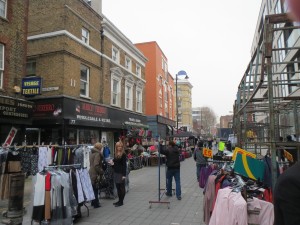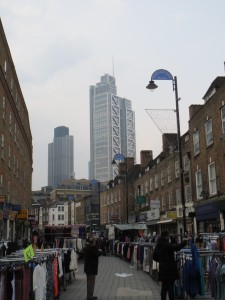When you are done at the synagogue, return to the main street (Bevis Marks) and continue north before going down the first street on the right, Goring St. Turn left on Houndsditch and right on to Cutler St. almost immediately. Follow Cutler St. taking a right turn at the intersection with Devonshire Square. Take the first left going up Harrow Pl and continue until you reach:
SIGHT (Middlexsex St. / Petticoat Lane): You are now crossing over into East End proper, Middlesex Street representing (as Mansell Street a bit to the south) the border between the City of London and the so-called London Borough of Tower Hamlets. You will not leave this borough again until the end of the tour.
Depending on the day and time of your visit, you will also be in the middle of the Petticoat Lane Market, one of the oldest surviving markets in Britain. The Middlesex St part of the market is only open on Sundays, while the adjacent Wentworth Street Market is open all weekdays bar Saturday. The market has been known to exist in some form or other since the early 17th century, when it was a commercial district where second-hand clothes and bric-á-brac were sold. Near the end of the 17th century many huguenots settled in the area, fleeing religious persecution in catholic France. The huguenots counted many master weavers among their number, and this reinforced the association of the East End/Spitalfields area with the clothing industry. These days most of the stallholders and inhabitants of the area are of an Asian origin, especially from the south east and from the Indian subcontinent, with about one quarter of the inhabitants of the entire borough identifying themselves as Bangladeshis. On the large market days, the market features more than 300 individual stallholders, and although the fabric is of a varying quality, there are always some good bargains to be found. There are also some very good street food vendors, and it is not unusual for a queue to go on for 50 meters for some of the more popular ones.
Despite lying in the shadows of the financial district, these streets also feature a number of fairly well-preserved (or at least “not demolished”) examples of Victorian housing (last half of the 19th century), which may give you some idea of the environment in which Jack the Ripper hunted down prostitutes almost 130 years ago. The area was then one of the poorest in the entire London area, and it was also this neighbourhood which Jack London infamously wrote about in his 1903 book “The People of the Abyss”.
Now continue along Wentworth St, just a short walk to the right of where you entered Middlesex St.
SIGHT (Wentworth Dwellings/Jack the Ripper): Take a small turn on Goulston Street, walking down to the Happy Days restaurant. The building containing the restaurant was erected in 1886/7 as a block of model dwellings known as the Wentworth Dwellings. A number of model dwellings were raised in the area by private companies in the last half of the 19th century, in an attempt to ameliorate overcrowding and the moral and sanitary problems resulting from it. As such it was a part capitalistic part philantropic predecessor to council housing, and the top floors of the present-day Wentworth Dwellings are an excellent example of the model dwellings of the era.
By 1888 almost the entire population of the Wentworth Dwellings was Jewish, and in the early morning of September 30 of that year, Police Constable Alfred Long discovered in the doorway of 108-119 Wentworth Dwellings a blood covered part of an apron belonging to the afore mentioned Catherine Eddowes – the prostitute who had been murdered in Mitre Square just a short time before. Above the apron was some recently written graffito reading “The Juwes are the men that will not be blamed for nothing“. It was never established whether the graffito was actually written by the murderer, but afraid that it might instigate riots aimed against the local Jewish population, DS Thomas Arnold and Commissioner of the Metropolitan Police, Sir Charles Warren, had it swiftly removed before it was even photographed. This has been the subject of some controversy to this day.
The Wentworth Dwellings themselves were due to be demolished in the late 1960s and again in 1982, when the last remaining inhabitants of what was then a run-down slum were re-housed and the building itself boarded up. For a few years nothing happened, but then in 1990 the buildings were refurbished and renamed Merchant House. The doorway which contained the Goulston Street Graffito is now part of the entrance to the Happy Days restaurant.
Walk back to Wentworth Street and continue along it until you reach the major thoroughfare of Whitechapel, Commercial Street.


